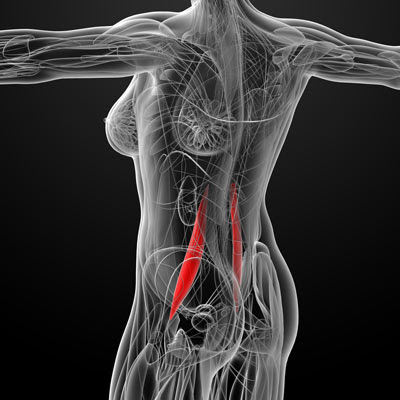7 Ways to Tell if You Have a Psoas Muscle Imbalance
When you have a tight (or short) psoas muscle, you may experience pain in your lower back or in your hips, especially when lifting your legs. This is caused by the muscle compressing the discs in the lumbar region of your back.
Stretching your muscles and releasing the tension on the psoas is the best way to prevent this from happening. It takes time and daily attention to keep your psoas muscles relaxed, stretched, and strong.
And, while most people with psoas issues have tight psoas muscles, there are some people whose psoas muscles can be overstretched. In this case, if you stretch your psoas and it is already overstretched, you will cause more problems.
Your body will tell you what your psoas ultimately needs. Here are 7 ways to tell if you have a psoas muscle imbalance:
Leg length discrepancy
A tight psoas muscle can cause your pelvis to rotate forward. This in turn can cause an an internal rotation of your leg on the affected side. The opposite leg will rotate externally in an effort to counter-balance.
This will make the affected leg longer so that every time you take a step, it drives your leg up into your hip socket. This can lead to functional leg length discrepancy.
Knee and low back pain
If you experience knee or low back pain with no apparent cause, it may be coming from your psoas muscles. When your femur is in essence locked into your hip socket due to a tight psoas muscle, rotation in the joint can’t occur. This can cause your knee and low back to torque.
Postural problems
When your psoas is too short or tight, it can pull your pelvis into an anterior tilt, compressing the spine and pulling your back into hyperlordosis or “duck butt.”If your psoas is overstretched or weak, it can flatten the natural curve of your lumbar spine creating a “flat butt.” This misalignment is characterized by tight hamstrings pulling down on the sitting bones, which causes the sacrum to lose its natural curve and results in a flattened lumbar spine.
This can lead to low-back injury, especially at the intervertebral discs. You may also feel pain at the front of your hip. Finally, it is possible for your psoas muscles to be both tight and overstretched. In this case, your pelvis is pulled forward in front of your center of gravity, causing your back to curve (swayback) and your head to poke forward.
Difficulty moving your bowels
A tight psoas muscle can contribute to or even cause constipation. A large network of lumbar nerves and blood vessels passes through and around the psoas muscles. Tightness in the psoas muscles can impede blood flow and nerve impulses to the pelvic organs and legs.
In addition, when the psoas is tight your torso shortens decreasing the space for your internal organs. This affects food absorption and elimination. As such it can contribute to constipation, as well as sexual dysfunction.
Menstrual Cramps
An imbalance in your psoas muscles can be partially responsible for menstrual cramps as it puts added pressure in your reproductive organs.
Chest breathing
A tight psoas muscle can create a thrusting forward of the ribcage. This causes shallow, chest breathing, which limits the amount of oxygen taken in and encourages over usage of your neck muscles.
Feeling exhausted
Your psoas muscles create a muscular shelf that your kidneys and adrenals rest on. As you breathe properly your diaphragm moves and your psoas muscles gently massage these organs, stimulating blood circulation. But, when the psoas muscles become imbalanced, so do your kidneys and adrenal glands, causing physical and emotional exhaustion.
9 Tips for Keeping Your Psoas Muscles Happy and Healthy
Exercise, sitting in your favorite chair, wearing shoes, and even unhealed physical and emotional injuries can cause imbalance in your psoas muscles. Getting things back in balance will give you a greater range of motion and relief from pain. Plus, you feel more grounded and relaxed!
Here are some tips for getting things back in balance:
Avoid sitting for extended periods.
If you must sit for work or other reasons, sit with good posture and be sure your hips are level or slightly higher than your knees. Avoid bucket seats and chairs without support for your low back. Try to get up and move around every hour.
Add support to your car seat.
Use a rolled up towel underneath your sit bones and/ or behind your lumbar spine to keep the psoas and hip sockets released. If you are traveling long distances, stop every 3 hours to stretch and walk around for 10 minutes.
Lay off extreme exercise routines.
We don’t mean completely or forever. But, if you are a power walker, distance runner or sprinter, or even if you do a lot of sit-ups, you may want to alternate your workouts.
Try Resistance Flexibility exercises.
Resistance Flexibility exercises can do wonders for your fascia.
To strengthen your psoas, lay on your back with your hips abutting the wall next to a door frame. Raise one leg straight so that it is against the wall. (Your other leg will extend through the door way.) Bend your extended leg and using your hands to slow down the movement and create resistance, bring your bent knee toward your chest.
Do this while also pressing your raised leg into the wall. Then reverse the motion of your bent leg. As you straighten it, continue to create resistance using your hands to push your leg out as your leg resists.


